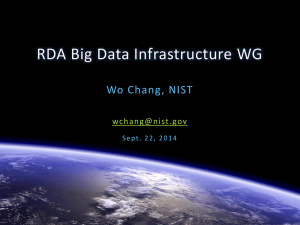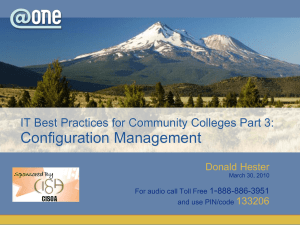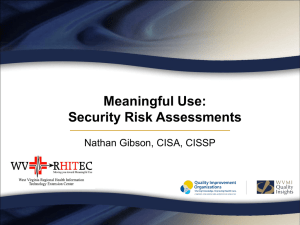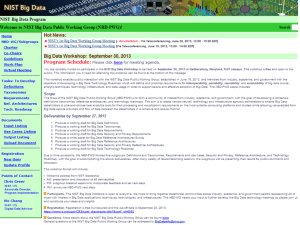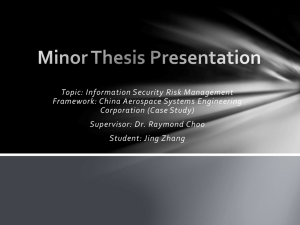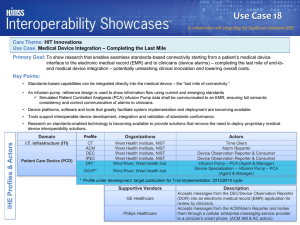NIST Big Data Public Working Group & Standardization Activities
advertisement
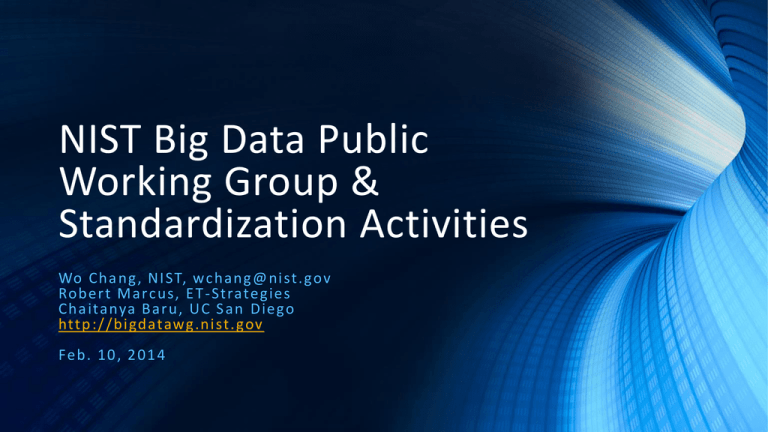
NIST Big Data Public Working Group & Standardization Activities Wo C h a n g , N IST, wc h a n g@nist . gov Ro b e rt M a rc u s, E T - S t rate g ie s C h a ita nya B a ru , UC S a n D ie go htt p : / / bigdatawg.nist . gov Fe b . 1 0 , 2 0 1 4 Agenda • Why Big Data? Why NIST? • NBD-PWD Charter and Deliverables • Overall Work Plan • Subgroup Charter and Deliverables Definitions & Taxonomies Requirements & Use Case Security & Privacy • Next Steps / Future Activities • ISO/IEC JTC 1 Big Data Study Group Reference Architecture Technology Roadmap 2014 ESIP, NIST/ITL, Wo Chang, Feb. 20, 2014 2 Why Big Data? Why NIST? • Why Big Data? There is broad agreement among commercial, academic, and government leaders about the remarkable potential of “Big Data” to spark innovation, fuel commerce, and drive progress. • Why NIST? (a) Recommendation from January 15 -- 17, 2013 Cloud/Big Data Forum and (b) A lack of consensus on some important, fundamental questions is confusing potential users and holding back progress. Questions such as: • What are the attributes that define Big Data solutions? • How is Big Data different from traditional data environments and related applications? • What are the essential characteristics of Big Data environments? • How do these environments integrate with currently deployed architectures? • What are the central scientific, technological, and standardization challenges needed to accelerate the deployment of robust Big Data solutions? 2014 ESIP, NIST/ITL, Wo Chang, Feb. 20, 2014 3 Why Big Data? Why NIST? • Why Big Data? There is broad agreement among commercial, academic, and government leaders about the remarkable potential of “Big Data” to spark innovation, fuel commerce, and drive progress. • Why NIST? (a) Recommendation from January 15 -- 17, 2013 Cloud/Big Data Forum and (b) A lack of consensus on some important, fundamental questions is confusing potential users and holding back progress. Questions such as: NBD-PWG is being launched to address these questions and is charged to develop consensus definitions, taxonomies, secure reference architecture, and technology roadmap for Big Data that can be embraced by all sectors. 2014 ESIP, NIST/ITL, Wo Chang, Feb. 20, 2014 4 NBD-PWG: Charter and Deliverables Charter (M0001) Deliverables - Working Drafts for: The focus of the (NBD-PWG) is to form a community of interest from industry, academia, and government, with the goal of developing a consensus definitions, taxonomies, secure reference architectures, and technology roadmap. The aim is to create vendor-neutral, technology and infrastructure agnostic deliverables to enable big data stakeholders to pick-and-choose best analytics tools for their processing and visualization requirements on the most suitable computing platforms and clusters while allowing value-added from big data service providers and flow of data between the stakeholders in a cohesive and secure manner. 1. Big Data Definitions 2. Big Data Taxonomies 3. Big Data Requirements & Use Cases 4. Big Data Security & Privacy Requirements 5. Architectures Survey 6. Big Data Reference Architecture 7. Big Data Security & Privacy Architecture 8. Big Data Technology Roadmap L AU N CH DAT E: Ju n e 2 6 , 2 0 1 3 TA RGET DAT E: S e ptem ber 2 7 , 2 0 1 3 2014 ESIP, NIST/ITL, Wo Chang, Feb. 20, 2014 5 2014 ESIP, NIST/ITL, Wo Chang, Feb. 20, 2014 6 Requirements and Use Cases Technology Roadmap SUBGROUPS Reference Architecture NBDPWG Definitions & Taxonomies Security and Privacy A N D TH E IR S CO PES A N D D E L I VERA BL ES 2014 ESIP, NIST/ITL, Wo Chang, Feb. 20, 2014 7 SUBGROUP Scope (M0020) Requirements & Use Cases Geoffrey Fox, U. Indiana Joe Paiva, VA Tsegereda Beyene, Cisco The focus is to form a community of interest from industry, academia, and government, with the goal of developing a consensus list of Big Data requirements across all stakeholders. This includes gathering and understanding various use cases from diversified application domains. Tasks • Gather input from all stakeholders regarding Big Data requirements. • Analyze/prioritize a list of challenging general requirements that may delay or prevent adoption of Big Data deployment • Develop a comprehensive list of Big Data requirements Definitions and Taxonomies Technology Roadmap Reference Architecture Requirements NBDPWG Security and Privacy 2014 ESIP, NIST/ITL, Wo Chang, Feb. 20, 2014 8 Requirements and Use Case Subgroup Key documents: M0105 – Use Cases M0125 – Requirements Mo152 – Working Draft Use Case Template: 1. Goals, Description 2. Data Characteristics, Data Types 3. Data Analytics 4. Current Solutions 5. Security & Privacy 6. Lifecycle Management & Data Quality 7. System Management & Other Issues 2014 ESIP, NIST/ITL, Wo Chang, Feb. 20, 2014 9 Requirements and Use Case Subgroup 51 Use Cases Received (http://bigdatawg.nist.gov/usecases.php) 1. Government Operations (4): National Archives & Records Administration, Census Bureau 2. Commercial (8): Finance in Cloud, Cloud Backup, Mendeley (Citations), Netflix, Web Search, Digital Materials, Cargo shipping (e.g. UPS) 3. Defense (3): Sensors, Image Surveillance, Situation Assessment 4. Healthcare & Life Sciences (10): Medical Records, Graph & Probabilistic Analysis, Pathology, Bio-imaging, Genomics, Epidemiology, People Activity Models, Biodiversity 5. Deep Learning & Social Media (6): Driving Car, Geolocate Images, Twitter, Crowd Sourcing, Network Science, NIST Benchmark Datasets 6. The Ecosystem for Research (4): Metadata, Collaboration, Language Translation, Light Source Experiments 7. Astronomy & Physics (5): Sky Surveys, Large Hadron Collider at CERN, Belle Accelerator II (Japan) 8. Earth, Environmental & Polar Science (10): Ice Sheet Scattering, Earthquake, Ocean, Earth Radar Mapping, Climate Simulation, Atmospheric Turbulence, Subsurface Biogeochemistry, AmeriFlux &FLUXNET gas sensors 9. Energy (10): Smart Grid 2014 ESIP, NIST/ITL, Wo Chang, Feb. 20, 2014 10 Requirements and Use Case Subgroup Extract requirements and map to reference architecture based on application characteristics: a. Data sources (data size, file formats, rate of growth, at rest or in motion, etc.) b. Data lifecycle management (curation, conversion, quality check, pre-analytic processing, etc.) c. Data transformation (data fusion/mashup, analytics) d. Capability infrastructure (software tools, platform tools, hardware resources like storage and networking) e. Data usage (processed results in text, table, visual, other formats) f. 437 requirements were extracted from 51 Use Cases All architecture components informed by Goals and Use Case description 35 aggregated general requirements divided into 7 categories g. Security & Privacy has direct map Aggregate all specific requirements into high-level generalized requirements which are vendor-neutral and technology agnostic 2014 ESIP, NIST/ITL, Wo Chang, Feb. 20, 2014 11 Part of Property Summary Table Requirements and Use Case Subgroup 2014 ESIP, NIST/ITL, Wo Chang, Feb. 20, 2014 12 SUBGROUP Scope (M0018) Definitions & Taxonomies Nancy Grady, SAIC Natasha Balac, SDSC Eugene Luster, R2AD The focus is to gain a better understanding of the principles of Big Data. It is important to develop a consensus-based common language and vocabulary terms used in Big Data across stakeholders from industry, academia, and government. In addition, it is also critical to identify essential actors with roles and responsibility, and subdivide them into components and subcomponents on how they interact/ relate with each other according to their similarities and differences. Tasks • For Definitions: Compile terms used from all stakeholders regarding the meaning of Big Data from various standard bodies, domain applications, and diversified operational environments. • For Taxonomies: Identify key actors with their roles and responsibilities from all stakeholders, categorize them into components and subcomponents based on their similarities and differences Definitions and Taxonomies Technology Roadmap Reference Architecture • Develop Big Data Definitions and taxonomies documents Requirements NBDPWG Security and Privacy 2014 ESIP, NIST/ITL, Wo Chang, Feb. 20, 2014 13 Definitions and Taxonomies Subgroup (M0024, M0142) Key documents: M0024 – Ongoing Discussion M0142 – Working Draft Big Data Definitions, v1 (Developed from Jan. 15-17, 2013 NIST Cloud/Big Data Workshop) Big Data refers to digital data volume, velocity and/or variety that: Big Data consists of extensive datasets, primarily in the characteristics of volume, velocity and/or variety, that require a scalable architecture for efficient storage, manipulation, and analysis. 2014 ESIP, NIST/ITL, Wo Chang, Feb. 20, 2014 14 Definitions and Taxonomies Subgroup (M0024, M0142) • Data Science is the extraction of actionable knowledge directly from data through a process of discovery, hypothesis, and analytical hypothesis analysis. • Data Scientists is a practitioner who has sufficient knowledge of the overlapping regimes of expertise in business needs, domain knowledge, analytical skills and programming expertise to manage the end-to-end scientific method process through each stage in the Big Data lifecycle (through action) to deliver value. 2014 ESIP, NIST/ITL, Wo Chang, Feb. 20, 2014 15 Definitions and Taxonomies Subgroup (M0024, M0142) Big Data Taxonomies (M0202) Actors System Roles 1. 2. 3. 4. 5. 6. 7. 1. Sensors Applications Software agents Individuals Organizations Hardware resources Service abstractions 2. 3. 4. 5. Data Provider > Makes available data internal and/or external to the system Data Consumer > Uses the output of the system System Orchestrator > Governance, requirements, monitoring Big Data Application Provider > Instantiates application Big Data Framework Provider > Provides resources 2014 ESIP, NIST/ITL, Wo Chang, Feb. 20, 2014 16 Definitions and Taxonomies Subgroup (M0024, M0142) Big Data Taxonomies (M0202) 2014 ESIP, NIST/ITL, Wo Chang, Feb. 20, 2014 17 Definitions and Taxonomies Subgroup (M0024, M0142) Big Data Taxonomies (M0202) 2014 ESIP, NIST/ITL, Wo Chang, Feb. 20, 2014 18 SUBGROUP Scope (M0021) Reference Architecture Orit Levin, Microsoft James Ketner, AT&T Don Krapohl, Augmented Intelligence The focus is to form a community of interest from industry, academia, and government, with the goal of developing a consensus-based approach to orchestrate vendor-neutral, technology and infrastructure agnostic for analytics tools and computing environments. The goal is to enable Big Data stakeholders to pick-and-choose technology-agnostic analytics tools for processing and visualization in any computing platform and cluster while allowing value-added from Big Data service providers and the flow of the data between the stakeholders in a cohesive and secure manner. Tasks • Gather and study available Big Data architectures representing various stakeholders, different data types,’ use cases, and document the architectures using the Big Data taxonomies model based upon the identified actors with their roles and responsibilities. • Ensure that the developed Big Data reference architecture and the Security and Privacy Reference Architecture correspond and complement each other. Definitions and Taxonomies Technology Roadmap Reference Architecture Requirements NBDPWG Security and Privacy 2014 ESIP, NIST/ITL, Wo Chang, Feb. 20, 2014 19 Reference Architecture Subgroup Key documents: M0151 – White Paper M0123 – Working Draft M0039 | Data Processing Flow M0017 | Data Transformation Flow M0047 | IT Stack 2014 ESIP, NIST/ITL, Wo Chang, Feb. 20, 2014 20 Reference Architecture Subgroup Vendors Big Data Architectures 2014 ESIP, NIST/ITL, Wo Chang, Feb. 20, 2014 21 Reference Architecture Subgroup What the Baseline Big Data RA IS A superset of the “traditional data” system A representation of a vendor-neutral & technology agnostic system A functional architecture comprised of logical roles Applicable to a variety of business models: o Tightly-integrated enterprise systems o Loosely-coupled vertical industries IS NOT A business architecture representing internal vs. external functional boundaries A deployment architecture A detailed IT RA of a specific system implementation All of the above will be developed in the next stage in the context of specific use cases. 2014 ESIP, NIST/ITL, Wo Chang, Feb. 20, 2014 22 Reference Architecture Subgroup RA Diagram 2014 ESIP, NIST/ITL, Wo Chang, Feb. 20, 2014 23 SUBGROUP Scope (M0019) Security & Privacy Arnab Roy, CSA/Fujitsu Nancy Landreville, U. MD Akhil Manchanda, GE The focus is to form a community of interest from industry, academia, and government, with the goal of developing a consensus secure reference architecture to handle security and privacy issues across all stakeholders. This includes gaining an understanding of what standards are available or under development, as well as identifies which key organizations are working on these standards. Tasks • Gather input from all stakeholders regarding security and privacy concerns in Big Data processing, storage, and services. • Analyze/prioritize a list of challenging security and privacy requirements that may delay or prevent adoption of Big Data deployment • Develop a Security and Privacy Reference Architecture that supplements the general Big Data Reference Architecture Definitions and Taxonomies Technology Roadmap Reference Architecture Requirements NBDPWG Security and Privacy 2014 ESIP, NIST/ITL, Wo Chang, Feb. 20, 2014 24 Security and Privacy Subgroup Key documents: Google Doc – Ongoing Discussion M0110 – Requirements Working Draft M0xxx – Architecture & Taxonomies Requirements Scope Requirements – Use Cases Studied • Infrastructure Architecture & Taxonomies Security • Data Privacy • Data Management • Integrity & Reactive Security • Privacy • Provenance • System Health • Retail (consumer) • Healthcare • Media • Government • Marketing 2014 ESIP, NIST/ITL, Wo Chang, Feb. 20, 2014 25 SUBGROUP Scope (M0022) Technology Roadmap Carl Buffington, USDA/Vistronix Dan McClary, Oracle David Boyd, Data Tactic The focus is to form a community of interest from industry, academia, and government, with the goal of developing a consensus vision with recommendations on how Big Data should move forward by performing a good gap analysis through the materials gathered from all other NBD subgroups. This includes setting standardization and adoption priorities through an understanding of what standards are available or under development as part of the recommendations. Tasks • Gather input from NBD subgroups and study the taxonomies for the actors’ roles and responsibility, use cases and requirements, and secure reference architecture. • Gain understanding of what standards are available or under development for Big Data • Perform a thorough gap analysis and document the findings Definitions and Taxonomies Technology Roadmap Reference Architecture Requirements NBDPWG • Identify what possible barriers may delay or prevent adoption of Big Data • Document vision and recommendations Security and Privacy 2014 ESIP, NIST/ITL, Wo Chang, Feb. 20, 2014 26 Technology Roadmap Subgroup Key document: M0087 – Working Draft • Inputs from other subgroups Definitions & Taxonomies Security & Privacy • Potential Standards Group with Big Data-related activities (M0035) • Capabilities & Technology Readiness Requirements & Use Cases Reference Architecture • Big Data Decision Framework • Big Data Mapping & Gap Analysis • Big Data Strategies Adoption Implementation Resourcing 2014 ESIP, NIST/ITL, Wo Chang, Feb. 20, 2014 27 Subgroups Working Draft Outline Contact: bigdatainfo@nist.gov Website: http://bigdatawg.nist.gov Join NBD-PWG: http://bigdatawg.nist.gov/newuser.php Documents: http://bigdatawg.nist.gov/show_InputDoc.php Working Drafts http://bigdatawg.nist.gov/V1_output_docs.php Big Data Definitions & Taxonomies (M0142) Big Data Requirements (M0245) Big Data Security & Privacy Requirements (M0110) Big Data Architectures White Paper Survey (M0151) Big Data Reference Architectures (M0226) Big Data Security & Privacy Reference Architecture (M0110) Big Data Technology Roadmap (M0087) NIST Big Data Workshop Slides: http://bigdatawg.nist.gov/workshop.php 2014 ESIP, NIST/ITL, Wo Chang, Feb. 20, 2014 28 N EXT STEPS & FUTURE ACTIVITIES 2013 Big Data World Congress, NIST/ITL, Wo Chang, Dec. 3, 2013 29 ISO/IEC JTC 1 Big Data Study Group Convener: Wo Chang, NIST Terms and References: 1. 2. 3. 4. Survey the existing ICT landscape for key technologies and relevant standards/models/studies/use cases and scenarios for Big Data from JTC 1, ISO, IEC and other standards setting organizations Identify key terms and definitions commonly used in the area of Big Data Assess the current status of Big Data standardization market requirements, identify standards gaps, and propose standardization priorities to serve as a basis for future JTC 1 work Provide a report with recommendations and other potential deliverables to the 2014 JTC1 Plenary Focus Areas: 1. Big Data Architecture / Infrastructure 2. Big Data Security & Privacy 3. Big Data Analytics 4. Big Data Applications & Tools 5. Big Data Management Meetings (3 face-to-face + teleconferences): Format – 4 days (2 days workshop + 2 day meetings) March – U.S. May – Europe June – Asia Additional Notes: 1. Workshop papers will go into NIST Special Publication 2. High-quality papers may go into ACM Conference Proceedings (in process) 3. Report due in September, 2014 2014 ESIP, NIST/ITL, Wo Chang, Feb. 20, 2014 30 Earth Science Information Partners (ESIP) • “…participation in the ESIP Federation is beneficial because it provides an intellectual commons to expose, gather and enhance in-house capabilities in support of an organization’s own mandate.” Source: http://www.esipfed.org/ 2014 ESIP, NIST/ITL, Wo Chang, Feb. 20, 2014 31 Earth Science Information Partners (ESIP) • “…participation in the ESIP Federation is beneficial because it provides an intellectual commons to expose, gather and enhance in-house capabilities in support of an organization’s own mandate.” Source: http://www.esipfed.org/ 2014 ESIP, NIST/ITL, Wo Chang, Feb. 20, 2014 32 RDA Big Data Infrastructure WG (RDA + NIST Big Data PWG) The focus of the Research Data Alliance (RDA)’s BDI-WG is to establish best practices implementation guidelines for how to deploy and manage big data applications using NIST Big Data Public Working Group’s Reference Architecture and other big data architectures along with best technologies available today to meet the ever challenging big data application demands. The rate at which data volumes, speeds, and complexity are growing requires new forms of computing infrastructure to enable breakthrough discoveries and innovation in ways that enhance economic security and improve quality of life. 2014 ESIP, NIST/ITL, Wo Chang, Feb. 20, 2014 33 NBD-PWG and BDI-WG Tasks and Deliverables NBD-PWG Tasks • Select/identify unique Big Data scenarios from the submitted use cases • Work with use case submitters to identify unique Big Data scenarios and requirements for actual implementations. This includes security and privacy concerns and requirements • Work with the BDI-WG to develop high-level interface calls between RA key components by learning how the low-level implementation work • Establish preliminary high-level interface abstraction between RA key components BDI-WG Tasks • • • • Work with NBD-PWG to understand the RA structure and identified use cases Identify best Big Data technologies and solutions to implement the identified use cases Work with the use case submitters to implement their use cases Document the implementation process 2014 ESIP, NIST/ITL, Wo Chang, Feb. 20, 2014 34 2014 ESIP, NIST/ITL, Wo Chang, Feb. 20, 2014 35 NBD-PWG and BDI-WG Tasks and Deliverables NBD-PWG Tasks • Select/identify unique Big Data scenarios from the submitted use cases • Work with use case submitters to identify unique Big Data scenarios and requirements for actual implementations. This includes security and privacy concerns and requirements • Work with the BDI-WG to develop high-level interface calls between RA key components by learning how the low-level implementation work • Establish preliminary high-level interface abstraction between RA key components BDI-WG Tasks • • • • Work with NBD-PWG to understand the RA structure and identified use cases Identify best Big Data technologies and solutions to implement the identified use cases Work with the use case submitters to implement their use cases Document the implementation process 2014 ESIP, NIST/ITL, Wo Chang, Feb. 20, 2014 36 Provisioning Tool: Ubuntu JuJu with Charms Charms (https://juju.ubuntu.com/) Scalable application services defined Charms give Juju its power. They encapsulate application configurations, define how services are deployed, how they connect to other services and are scaled. Charms are easily shared and there are 100s of Charms already rated and reviewed in our Charm store. 2014 ESIP, NIST/ITL, Wo Chang, Feb. 20, 2014 37 Provisioning Tool: Ubuntu JuJu with Charms using GUI 2014 ESIP, NIST/ITL, Wo Chang, Feb. 20, 2014 38 Provisioning Tool: Dell Crowbar with Barclamps Modular Design: Barclamps Dell “Crowbar” Ops Management APIs, User Access, & Ecosystem Partners Ganglia Dashboard Nova Swift Glance Compellent EqualLogic Crowbar DNS Logging Deployer NTP Provisioner BIOS Network RAID Cloud Infrastructure & Dell IP Extensions Core Components & Operating Systems Physical Resources Dell Cloud Solutions Nagios IPMI * Crowbar has potential to service other programs beyond OpenStack 2014 ESIP, NIST/ITL, Wo Chang, Feb. 20, 2014 39 Provisioning Tool: Dell Crowbar with Barclamps using Manager 2014 ESIP, NIST/ITL, Wo Chang, Feb. 20, 2014 40 Provisioning Tool: Puppet with the Master/Agent Dataflow Puppet Dataflow 2014 ESIP, NIST/ITL, Wo Chang, Feb. 20, 2014 41 Provisioning Tool: Puppet with the Master/Agent Dataflow 2014 ESIP, NIST/ITL, Wo Chang, Feb. 20, 2014 42 Provisioning Tool: Puppet with the Master/Agent Dataflow 2014 ESIP, NIST/ITL, Wo Chang, Feb. 20, 2014 43 Questions? PL EA S E CO N TAC T: WC H A NG@NIST.GOV
